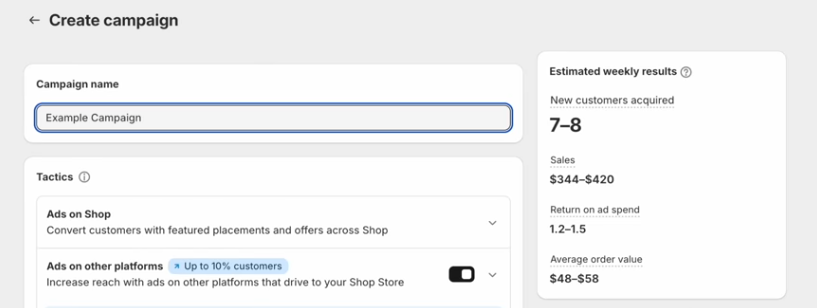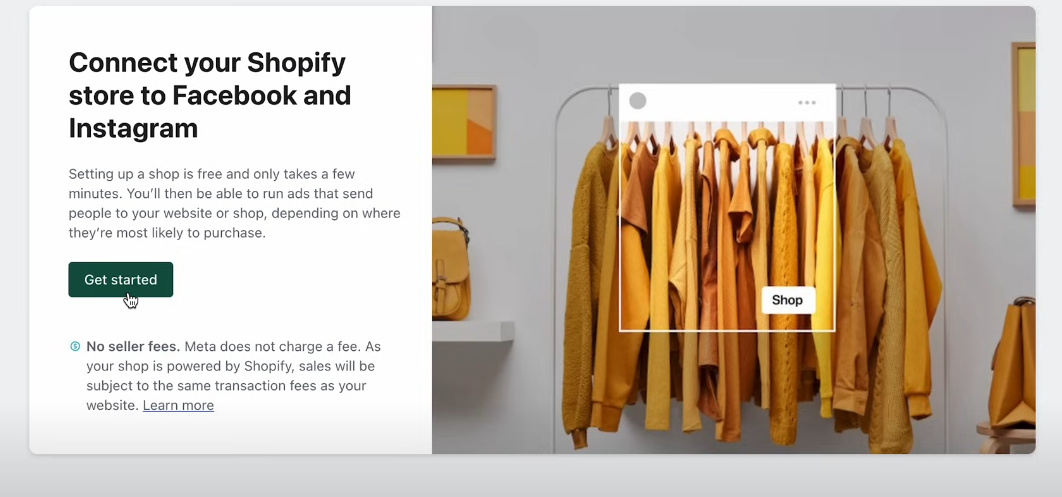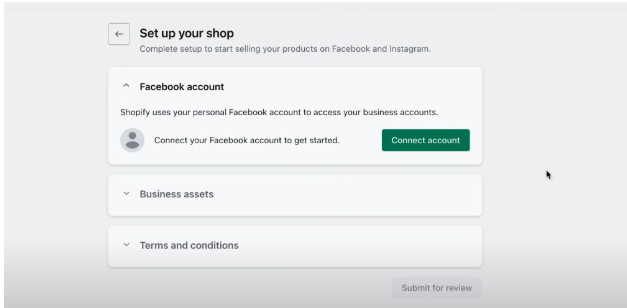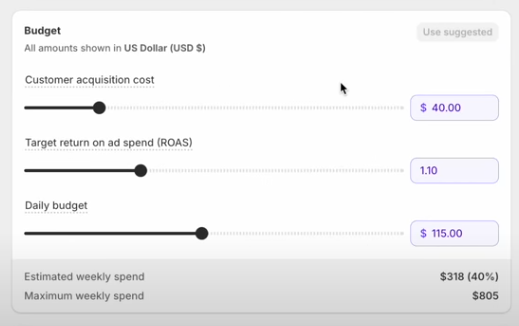How to Run Ads on Shopify and Finally Get Steady Sales
Most successful Shopify stores have one thing in common: they run ads. When it comes to advertising on Shopify, you have two main options: Shopify's native Shop campaigns or running Meta ads through your own accounts. This article breaks down when to use each method and exactly how to get started with whichever option fits your needs.


When OptiMonk analyzed 1,000 Shopify stores, they found that 77.4% use Meta Ads.
If your store is not doing the same, you’re doing it a huge disservice, and it’s costing you thousands of potential customers.
Today, we’ll walk you through how to run ads on Shopify.
There are two main ways to do this:
- Natively on the Shop App
- Through third-party apps (we’ll concentrate on Meta for this article)
We will cover both models and break down the pros and cons of each, so you know which makes the most sense for your store.
Let’s start with Shopify Shop campaigns.
Key takeaways
- 77.4% of top Shopify stores use Meta Ads to reach customers.
- Shopify's Shop campaigns charge you only when customers convert, and you set the maximum you're willing to pay per customer acquisition.
- Shop campaigns work only for US and Canadian stores, while Meta ads let you target customers worldwide.
- When setting an ad budget, aim to spend 10–20% of your customer lifetime value (CLV) to acquire a new customer.
What Are Shopify Shop Campaigns?
Shopify Shop Campaigns are ads that run directly inside the Shop app.
They’re only available to stores in the US and Canada.
The Shop Campaigns model is interesting because you only pay when a customer converts on the Shop app or Shop’s website.
Shopify sets minimum and recommended customer acquisition cost (CAC) values based on your store’s average order value. You’ll never be charged more than the maximum CAC you set.
With Shop campaigns, you can target both new and lapsed customers.
If your goal is to reach customers outside the US or Canada, you’ll want to skip to the section on Shopify ads via Meta.
Who is eligible for Shopify Shop campaigns?
Not every Shopify store can run Shop campaigns, so let’s look at the requirements.
- The store must be in the U.S. or Canada and have a Shopify Payments account in USD or CAD.
- Shop Pay must be activated.
- Stores must follow Shopify’s trust, safety, and fraud-prevention rules, plus Shop’s merchant requirements and third-party ad partner policies.
- Store must be at least 3 months old.
- Store must have at least 100 Shopify orders.
- Store must have a customer rating above 4.0 in the Shop app.
- If running ads on other platforms, Shopify Audiences setup and Meta account connection may be required.
- To advertise outside your primary market, you must enable international sales tools to show local currency.
If your store checks all these boxes, you’re ready to start setting up Shop campaigns.
Creating Shopify Shop Campaigns
Shop Campaigns is the umbrella term for ads that run through Shopify’s Shop channel. These campaigns can show up in #3 different ways:
Ads on the Shop app
These appear right inside the Shop app. They highlight special deals like discounts or bonus Shop Cash to encourage shoppers to buy from your store. You must be the store owner or have Shop channel and marketing permissions to create these ads.
Ads on Shopify Stores
These ads are automatically enabled once you start running Shop app campaigns. They appear on the Order Status and Thank You pages of Shopify stores that are part of the program.
The goal is to capture shoppers who have just purchased and are still in a buying mindset.
Ads on Other Platforms
When you enable this option, Shopify runs ads for you on external platforms like Meta or Google.
With this last type:
- The ads are displayed on Shop’s Facebook and Google accounts, not directly from your own accounts.
- Your products and offers are featured within Shop’s broader campaigns.
- You don’t control the ad account setup, billing, or targeting in detail. Shopify manages that part.
The only time we suggest using Ads on Other Platforms is if you don’t have the time, budget, or expertise to run your own accounts. Even then, we recommend setting up your own Meta ads for Shopify so you have more control and can build your brand better.
Like campaigns on any other platform, you can run multiple active campaigns simultaneously.
8 steps to create Shop ads
Now, let’s go through how to set up a Shop ad:
- In your Shopify admin, go to Settings > Apps and sales channels.
- Click Shop.
- Click Open sales channel.
- Go to Advertising and click Create campaign.
You can run your ads only on the Shop App or have them appear in Shopify Stores and other platforms.

- Under Objective, choose either Acquisition (to get new customers) or Win back (to re-engage past customers). If you pick Win back, select the time since their last order.
- In Customer acquisition cost, set the maximum you’re willing to pay per customer.
You can either follow the suggested budget or set your own, but Shopify requires it to be within their minimum and maximum limits.
In my experience, Shopify’s suggested spend works pretty well. I recommend adjusting the CAC based on your average conversion.

Fractional CMO at Dichele Group
- Fill in your campaign details: target order value, daily budget, countries, channels, campaign name, and schedule.
- Preview the estimated results and ad examples, and save the campaign if you’re happy with the setup.
For these campaigns, the ad performance metrics will display right on Shopify. These are the #5 metrics available:
- Gross sales (contains refunded and canceled orders)
- Number of shoppers who placed an order from the ads
- Return on ad spend (ROAS) of the campaign
- Average order value(AOV)
- Total ad spend of your campaigns
If you’d rather run Shopify ads for Meta on your own accounts, this next section covers it all.
Shopify ads via Meta
As we mentioned, Shop campaigns are not the only way to run ads on Shopify.
You can also run ads through Facebook and redirect traffic back to your Shopify store. In the next few paragraphs, we’ll show you how to do it.
How exactly do Shopify Facebook Ads work?
First, connect your Shopify store to Facebook and Instagram so your products sync automatically.
From there, you can run ad campaigns through Facebook Ads Manager to reach new customers. Any sales you make from those ads or social posts flow back into Shopify, where you can handle orders, payments, and returns.
To run these ads, you’ll need an active Shopify store, Meta Business Manager, and Meta Ads Manager. Be sure to check out the linked guides for the last two accounts we’ve mentioned.
Now that you’ve handled the basics, here’s how to link Meta to Shopify so you can begin advertising.
- On the Shopify app store, search for and install the Facebook and Instagram sales channel app.
This is the correct app. Double-check that before installation.

The app is super important because it allows you to control targeting, campaign management, and performance analytics of your Facebook Shopify ads.
- Go back to Shopify, under the sales channel, choose the Facebook and Instagram plugin, and connect your accounts.

When you’re done filling in the required details(see image below), submit for review.

Remember to create and connect a pixel to your Shopify store during setup. The pixel will help later on when you’re creating Facebook targeting for your ads.
- Sync your product catalog.
Facebook will directly import your product catalog to Shopify. However, if you want to manage the products in your catalog, you can change and edit them in the Facebook catalog manager.
- Create the campaign by going to https://www.facebook.com/ads/manager. From there, click Create campaign and choose your objective. For most Shopify stores, Sales is the best choice since it drives direct conversions.
We have a detailed guide on filling out the other sections, including ad sets and budgets. You can find it here: Meta Ads Manager Tutorial for eCommerce Ads.
With that in place, here are a few fundamental things to keep in mind when setting up your Shopify Meta ads.
The ad budget
Your budget will vary depending on your location, product, and the campaign objective you choose. We’ve covered this in detail here: Facebook Ad Budget: How Much to Spend + Benchmarks & Optimization Tips.
Sales campaigns on Facebook are usually more expensive than awareness campaigns, but the advantage is that they directly contribute to revenue.
Also, remember that your budget isn’t just for running ads. You’ll need wiggle room to test different creatives (images, copy, and audiences) before finding the right combination for your store.
Once your ads reach your target ROAS (for example, 3–4x), you can safely reinvest profits to scale your campaigns.
To give you a quick benchmark, here’s advice from Bridget O’Rourke of Learn With Shopify:
Figure out how much to spend on ads by looking at your customer lifetime value (CLV), cost per acquisition (CPA), and return on ad spend (ROAS). A good rule of thumb is to spend 10–20% of your CLV to acquire a customer, start with a small daily budget, and aim for at least a 3–4x return on your ad spend.

Learn With Shopify
Audience targeting
On Meta, you have #3 main audience options:
- Custom audiences: People you already have a connection with, such as past customers, website visitors, or email subscribers, that you can target directly with your ads.
- Lookalike audiences: Groups of new people who share similar traits and behaviors with your best existing customer. For example, you can upload your Shopify customer data or email list to create a lookalike audience.
- Advantage+ audiences: You let Meta’s algorithm automatically show your ads to people most likely to take action.
The other option (for choosing which audience to target) that we would recommend is to use Shopify Audiences.
This is a Shopify Plus feature that helps you find new customers by creating audience lists, which are groups of people more likely to buy from your store.
But there are a few caveats before you start using them:
- Only available for US and Canadian stores.
- You must be using Shopify Payments.
- You need to install the Shopify Audiences app.
These audience lists are sent directly to your connected ad accounts (like Meta or Google Ads), where you can run campaigns targeting them.
Because the audiences are based on the wider Shopify network, not just your store’s data, you benefit from insights across thousands of merchants.
In short, you get access to warmer audiences and take much guesswork out of targeting.
You can create #4 audience types with Shopify Audiences:
| Audience name | How to use it |
|---|---|
| Retargeting Boost | Targets people who engaged with your brand but haven’t purchased yet. Updates automatically every few days. |
| Prospecting | Finds new people similar to your buyers or to customers of related products. Refreshes every 1–2 weeks. |
| Meta Lookalike | Expands reach to similar shoppers across Meta in the U.S. and Canada (~9M users). Built from Retargeting Boost. |
| Existing Customers Plus | Includes your current customers. Use to exclude them from prospecting, re-engage them in remarketing, or enhance Advantage+ campaigns. |
The ad creatives
Since we’re using a sales objective, Facebook catalog ads will be your go-to ad format.
When you linked Facebook and Shopify earlier, your product catalog was automatically imported into Facebook. That means you can promote a single product or create product sets directly from your catalog.
Either way, your creative, whether it’s one image or a carousel from your product set, will be a deciding factor in performance.
A Nielsen study found that campaigns with high-quality creatives can perform up to 35% better than those with lower-quality creatives. And with so many businesses running ads on Facebook, you can’t afford to blend in with generic, low-quality images.
We recommend using a catalog enrichment platform such as Cropink to make your products look great and also highlight the details that matter most to shoppers.
For instance, with Cropink, you can:
- Create custom backgrounds that make product photos instantly more clickable
- Add pricing details, such as discounts, to make your ad offers attractive to shoppers
- Use on-image text to grab attention
- Showcase customer ratings for credibility
- Apply your brand colors, fonts, and logos so your ads are unmistakably yours
Instead of plain white backgrounds that look flat and forgettable, you’ll have ads that pop visually and communicate value at a glance. Like these examples below:

Beyond visuals, there are a few ad creative best practices to keep in mind:
- Incorporate UGC (user-generated content) for relatability and trust
- Optimize all ads for mobile, since most people will see them on their phones
- Stay authentic and ensure the ads match what customers actually receive
Check out this guide on Creative Ads Design for examples and inspiration.
Finally, remember that the copy is just as important as the visuals. Your ad copy should:
- Speak directly to your audience
- Highlight the benefit or value they’ll get from your product
- End with a clear call to action
For more detailed tips, see our guide on how to write the best ad copy.
Check in on your campaigns at least once a week. This gives your ads enough time to gather meaningful data without you reacting too quickly to small fluctuations.
It’s also a good idea to let campaigns run for at least 30 days. That way, you’ll have a clearer picture of your CAC, ROAS, and the ad spend level that works best for your Shopify store.
Should you run ads on Shopify?
We’ve gone digital, and everything and everyone, including your potential and existing customers, lives partly in this digital world. Unfortunately, organic Shopify marketing alone isn’t enough to compete against millions of other stores and still capture your customers’ attention.
You’ll need to set aside a Shopify advertising budget for channels like Google and Facebook to consistently reach and convert shoppers.
No matter which channel you choose, your ad creatives will have the biggest impact on performance. Cropink can help you enrich your catalog, showcase products in a way that stands out, and keep your brand consistent across every ad. You can explore how it works at Cropink.com.
FAQs
You can run ads natively through Shop campaigns, which appear in the Shop app, on Shopify stores, or even on other platforms managed by Shopify. You can also connect Shopify with Meta and run ads through your own accounts for more control.
The cost depends on your budget, product, and campaign objective. Stores spend anywhere from $300–$2,000+ for Meta advertising. Sales campaigns usually cost more than awareness campaigns but drive direct revenue. You can set your own budget, test creatives, and scale once you hit a profitable ROAS.
Shop ads can be valuable if you’re targeting US or Canadian customers and want a pay-per-conversion model. But if you want a broader reach and more control, running ads on platforms like Meta is often more profitable.

Damaris is a Digital Marketing Specialist who writes about digital marketing and performance marketing. At Cropink, she creates data-driven content to help businesses run better ad campaigns for better performance and ROI.

Leszek is the Digital Growth Manager at Feedink & Cropink, specializing in organic growth for eCommerce and SaaS companies. His background includes roles at Poland's largest accommodation portal and FT1000 companies, with his work featured in Forbes, Inc., Business Insider, Fast Company, Entrepreneur, BBC, and TechRepublic.
Related Articles
How does Shopify work? In 2026, it powers 2.5M+ live stores and supports global sellers with tools for building, managing, and growing an online business. This guide shows how Shopify works, from setup to checkout, with stats, tips, and zero coding required.

With over 2.7 billion people shopping online, standing out takes more than a good product. Find 12 ecommerce marketing strategies, with examples, industry benchmarks, and tips, to help you attract and retain your ideal customers.

We've compiled the most effective eCommerce marketing tools that successful online stores use to automate their campaigns and boost conversions. Each tool is evaluated for ease of use, pricing, and integration capabilities with popular platforms like Shopify.

Looking for Shopify store inspiration? Explore 30+ of the best Shopify stores in 2026—from fashion and beauty to tech and home. See what makes them stand out.

Shopify powers 4.8M+ stores in 2025—but what’s the real cost? From $5 starter plans to $399 advanced options (plus hidden fees), this no-fluff guide breaks down everything you need to know before you launch.

Struggling to get traffic on Shopify? You’re not alone—over 2.1M merchants are fighting for attention. Discover the 2025 ad strategies top sellers use to turn clicks into customers without burning cash.

Getting people to find your Shopify store is one thing. Getting them to buy is a whole other game. These 10 strategies help you build trust, attract the right customers, and turn traffic into sales without gimmicks.

Social commerce is reshaping how we shop—set to become a $1 trillion market by 2028. Discover which platforms are leading the charge and how tools like Cropink can help you sell directly inside social apps.

Facebook can become a full-on storefront if you know how to set it up right. This guide walks you through the necessary steps to create a Facebook Shop, get approved, and tweak it so shoppers trust you enough to hit buy.

eCommerce fraud is surging—global losses hit $44.3B in 2024 and could soar to $107B by 2029. Discover the latest fraud stats, rising threats like AI scams, and how to protect your online business in 2025.

Shopify Collective helps U.S. and Canadian retailers earn 20–40% profit without holding inventory. As ecommerce drives over a third of B2B revenue and global sales near $32.8T by 2026, learn how to scale your catalog and boost growth inside Shopify’s trusted ecosystem.

Shopify powers over 2.5M live stores in 2025—but that's after a massive 45.7% drop from last year. This data-packed breakdown reveals where the market is shrinking, who's growing (hello India and France), and why most of Shopify's 7.2M stores don’t survive.

How Can Cropink Help?
Start with Cropink is easy and free
No credit card required
